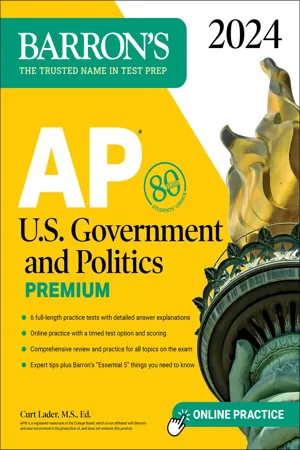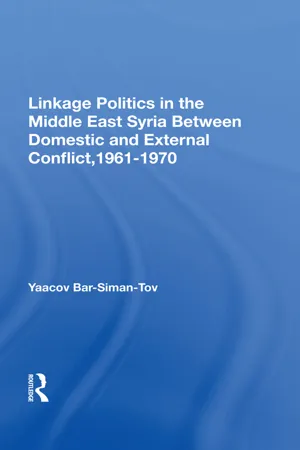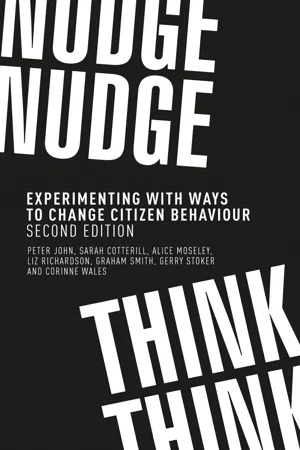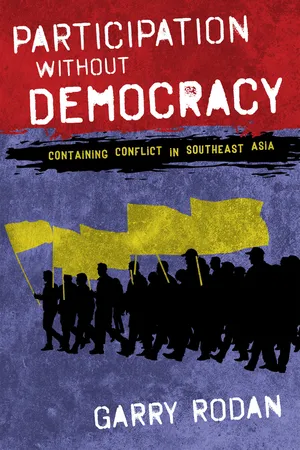Politics & International Relations
Linkage Institutions
Linkage institutions are channels that connect citizens to the government and political process. These institutions include political parties, interest groups, the media, and elections. They play a crucial role in shaping public opinion and influencing policy decisions.
Written by Perlego with AI-assistance
Related key terms
Related key terms
1 of 4
Related key terms
1 of 3
5 Key excerpts on "Linkage Institutions"
- No longer available |Learn more
- Curt Lader(Author)
- 2023(Publication Date)
- Barrons Educational Services(Publisher)
A working definition of government is those institutions that create public policy. Constitutionally defined, the formal institutions of government on the national level are the executive branch headed by the president, the legislative branch consisting of the Congress, and the judicial branch made up of the Supreme Court and lower courts. A similar structure exists on the state and local levels. In addition to government’s defined institutions, modern government is also characterized by those agencies that implement public policy—bureaucracies, including regulatory agencies, independent executive agencies, government corporations, and the cabinet. These institutions, sometimes acting independently, sometimes in concert, create and implement public policy. There are also Linkage Institutions that encourage political participation and utilize support to influence public policy. By definition, a linkage institution is the means by which individuals can express preferences regarding the development of public policy. Examples of Linkage Institutions are political parties, special-interest groups, and the media. Preferences are voiced through the political system, and when specific political issues are resolved, they become the basis for policy.Government, politics, and participation thus can be defined by a formula that combines the three concepts and reaches an end goal: government plus politics and participation equals the creation of public policy. In other words, what government does through politics and participation results in public policy.The media, through daily newspapers and television newscasts as well as columnists and editorials, attempt to influence the voters, the party, and the candidate’s stand on issues. The media have been accused of oversimplifying the issues by relying on photo opportunities (photo ops) set up by the candidates and on 30-second statements on the evening news (sound bites). The interaction of Linkage Institutions results in the formation of a policy agenda by the candidates running for elected office.People with similar needs, values, and attitudes will band together to form political parties. Once a political party is formed, in order for the needs, values, and attitudes to translate into actual policy, the party must succeed in electing members to office. Thus, individuals running for office must have a base of electoral support, a base of political support (the party), and a base of financial support. Obviously, the issue of incumbency comes into play as those elected officials who are reelected become entrenched in the system and have an advantage over young political hopefuls who want to break into the system. - eBook - ePub
Linkage Politics In The Middle East
Syria Between Domestic And External Conflict, 1961-1970
- Yaacov Bar-siman-tov(Author)
- 2019(Publication Date)
- Routledge(Publisher)
9An important aim of linkage politics is to establish a synthesis between international relations and political science. Without saying so explicitly, Rosenau also seems to believe that the concept of linkage politics can be extended to the two research levels of international relations, that of the state and of the system. On the state level, Rosenau tries to identify formation of a state’s foreign policy as a function of the interactions between internal political actors who are not within the ruling elite of a given state and the government or other internal political actors of another state. On the system level, Rosenau tries to identify how interactions between actors within the internal political environment of a given state and either the government itself or non-governmental internal political actors within other states in the system affect interactions within the international system.Conflict Linkage
“Conflict linkage” is an extension of linkage politics that focuses on the more limited aspect of the relationship between conflicts in the internal political environment of a given state and those of the international system. We can differentiate among three main approaches that deal with the relationship between internal and external conflict: the socio-psychological; the traditional; and the quantitative approach. These approaches are examined below in greater detail.The Socio-Psychological Approach
Many researchers in sociology and psychology have dealt with the connections between internal and external conflicts. In fact, most of the accepted hypotheses of conflict linkage research are derived from socio-psychological studies dealing either with individuals or various social groups. The present study is particularly indebted to Georg Simmel’s work, Conflict , and to Lewis Coser’s reformulation of that work.10 - eBook - ePub
Linkage Power Europe
The EU's Trade Negotiations with China (1975-2019)
- Zhang Xiaotong(Author)
- 2023(Publication Date)
- Routledge(Publisher)
linkage is that it leads to a possible change in a relative power relationship by linking something or somebody. By linking something, it is an issue linkage. By linking somebody, it is a party linkage. For the rest of linkage variants, they can be classified either as issue linkage or party linkage. In this section, I start with defining issue linkage and then defining its variants. The clarification of different linkages here is made to prepare for illustrating the EU’s linkage strategies in the following chapter.Defining issue linkage
Issue linkage is a typical and principal linkage strategy. As defined above, issue linkage is to lump together diverse issues so that compromises on one can be traded off against another in a grand deal.38 In essence, linkage is a way of packaging relevant power resources, either political, security, economic or institutional, so as to reinforce a bargaining position or, more generally, meet a specific policy objective in line with interests.In the IR theories, realists and the students of interdependence have divergences on issue linkage. Realists usually view international politics as a seamless web. Military and economically strong states will dominate a variety of organizations and a variety of issues, by linking their own policies on some issues to other states’ policies on other issues. By using their overall dominance to prevail on their weak issues, the strongest states will, in the traditional model, ensure a congruence between the overall structure of military and economic power and the pattern of outcomes on any one issue-area.39 Arthur Stein sees linkage as a key strategy for the US to counter its decline. He posits that when a country (the US) suffers such unbalanced or asymmetric decline – the loss of strength in one or more but not all issue-areas – an obvious response is for it to use its continued superiority in some areas in order to make up for its relative inferiority in others.40 - eBook - ePub
Nudge, nudge, think, think
Experimenting with ways to change citizen behaviour, second edition
- Peter John, Sarah Cotterill, Alice Moseley, Liz Richardson, Graham Smith, Gerry Stoker(Authors)
- 2019(Publication Date)
- Manchester University Press(Publisher)
11Linking
Why institutions are critical for citizen behaviourIf they are to be successful, nudge and think interventions need ways of linking citizens and political representatives in central and local government. Thinking makes more sense if the ideas that citizens come up with are reviewed, judged, and preferably acted upon by policy-makers. It is also possible to imagine situations where nudges work better with links, too. Some of the nudges described in this volume aim to get people involved in making decisions jointly with decision-makers, or to petition, lobby, or complain. Why participate if no one is listening?The institutional links between citizens and government provide a framework for citizen participation. Institutions have, in many cases, frustrated citizens’ ability to be citizens, and therefore institutional reform is vital. Many decision-makers themselves want to be more responsive. Concern continues, for example in the UK in the form of periodic inquiries, commissions, and calls for action (Department for Communities and Local Government 2007 , House of Commons Communities and Local Government Committee 2013 , Copus 2014 ).While the experiments and other research in this volume suggest there is untapped citizen potential, this can be hard to realize from the ways in which institutions frame the debate, how they create structures, and how they respond to citizens. Examples from everyday life are easy to come by: citizens can see where institutions promise choice and quality in public services but deliver long waits in doctors’ waiting rooms, where their questions about rapidly changing populations have been suppressed, where they are asked to come forward with opinions but ignored when their views are unsolicited, or that warnings about climate change come from the same politicians and civil servants who approve decisions to build new homes on flood plains. - eBook - ePub
Participation without Democracy
Containing Conflict in Southeast Asia
- Garry Rodan(Author)
- 2018(Publication Date)
- Cornell University Press(Publisher)
In contrast with much of the hybrid regime literature, the question to be asked about institutions is not whether they function according to some technical or idealized conceptions of institutions, but for whom they function and why. This necessitates explaining the emergence of institutions, the interests they serve, and how. More precisely, it means understanding political institutions as the embodiment of deeply rooted conflict over social and economic power, from which they should be analytically inseparable. Institutions are created to structure and limit the permissible bounds of participation and representation in deliberations and decisions concerning that social and economic power. As such, they are themselves sites of dynamic social and political conflict.The particular theoretical approach adopted here in analyzing institutions has been variously referred to as a social conflict approach (Rodan, Hewison, and Robison 1997, 2001, 2006), a social foundations approach (Rodan and Jayasuriya 2012), and the Murdoch School of political economy (Rasiah and Schmidt 2010, 16; Jones 2014; Pepinsky 2014).11 This approach occupies a distinctive place among attempts to situate institutions in their social and historical contexts. It includes, but goes beyond, the notion that political institutions are affected by social, structural, and historical factors, an insight that has been the basis of a range of previous sophisticated and illuminating studies (see Capoccia and Ziblatt 2010; Slater and Simmons 2010; Mø ller 2013).To be sure, there are approaches within both the hybrid and broader regimes literature fruitfully examining relationships between institutions, social structure, and history (see, for example, Ottaway 2003; Hawthorne 2004; Carothers 2006; Brownlee 2008; Levitsky and Way 2010, 321; Slater 2010). Nevertheless, political institutions in these works are ultimately viewed as instruments to elevate political engagement beyond societal or intraparty conflict, thereby regularizing and shaping political competition and/or sustaining the functionality of elite-dominated institutions (Rodan and Jayasuriya 2012; Pepinsky 2014). In essence, and by contrast, institutions are viewed here as inseparable from social conflict and related struggles over state power shaping access to, and control over, resources. The approach is consistent with Sangmpam’s (2007, 201) call for nothing less than analytically subordinating institutions to “society-rooted politics, the preeminent explanatory variable.” From a similar perspective, Poulantzas (1974, 63) explained: “Institutions do not determine social antagonisms: it is the class struggle which governs the modifications in the State apparatuses.”
Index pages curate the most relevant extracts from our library of academic textbooks. They’ve been created using an in-house natural language model (NLM), each adding context and meaning to key research topics.
Explore more topic indexes
Explore more topic indexes
1 of 6
Explore more topic indexes
1 of 4




